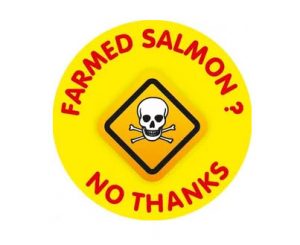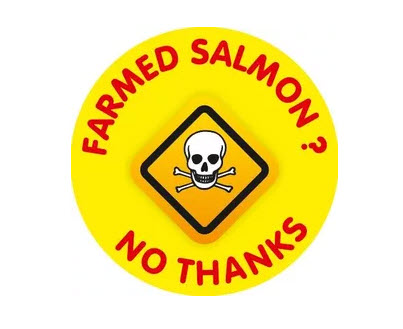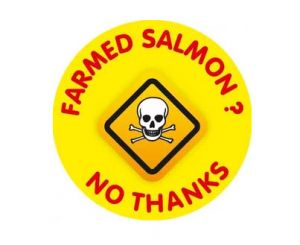Breaking news: It gives us no pleasure to report that according to Undercurrent News, two small land-based farms in Nova Scotia, Canada have lost approximately 600,000 small salmon due to an outbreak of ISA, a disease which naturally occurs in the region. This sad news reinforces the point that closed containment is not the panacea that critics of salmon farming claim it is.
Broken News: In years to come, lawmakers in Washington State may come to regret their decision yesterday to ban salmon farming when they end up with no farmed salmon and no wild salmon either. The problems of the wild salmon sector are not of the salmon farming industry’s making but as we often say, salmon farming is a convenient scapegoat.
The main message emanating from this blinkered decision is that it should be a massive wake up to the salmon farming industry everywhere that their existence is not a given. The likely outcome of the Scottish Parliament Environment Committee enquiry just shows how an important industry can be blindsided.
We have not read the exact legislation but in response Cooke Aquaculture should use their sea cages to grow large trout. There is clearly a market for portion sized ‘sea’ trout.
It doesn’t add up: One of the latest submissions loaded onto the Environment Committee website includes the following account: ‘I participated in salmon and seatrout angling on the River Add which drains into the Atlantic at Crinan in Argyll close to where I lived in Lochgilphead. Around the time I moved there salmon farming was becoming established in the immediate area. The River Add in 1987 and 1988 supported a very healthy stock of seatrout. Within a couple of years, the stock of seatrout in the River Add became virtually non-existent and that has become a situation right up and down the west coast of Scotland since that time. I have absolutely no doubt in my mind that the culprit of this decline is open cage salmon fish farming.’
This view seems to agree with that of the late Bruce Sandison who wrote to us back in 2013 identifying the rivers he believed to be in decline due to salmon farming. He wrote that for starters, we should look at the ‘River’s Fyne, Applecross, Add, Cree, Bladnoch and Nith.’
Interestingly, and to digress slightly, whilst Mr Sandison suggested to us that the fish stocks in the Nith are in decline due to the presence of salmon farming, Andrew Graham Stewart of Salmon & Trout Conservation, argued in Salmon & Trout magazine that the Nith still has stocks of large sea trout, something that rivers exposed to salmon farming no longer have. We are therefore unclear whether catches from the Nith are in decline due to the presence of salmon farming.
The late Bruce Sandison wrote extensively on the impacts of salmon farming and researched this subject thoroughly. Both he and the author of the ECCLR submission seem to agree that fish stocks in the River Add have suffered as a result of salmon farming.
Yet, the Friends of the Sound of Jura, who were invited to give evidence in person to the Committee state on their website that ‘the nearby River Add is one of the last good rivers for wild fish in mid-Argyll. The River Add is a popular and economically valuable wild salmon and sea trout river.’ Clearly, the River Add can’t be a good river for salmon and sea trout fishing whilst having no stocks of either fish!
The official catch data for the Add shows that sea trout have been in decline since records began in 1952 and salmon catches crashed in the mid 1960’s before salmon farming came to the west coast. As usual, what is blamed on salmon farming is very different in reality.
This week, the press widely reported that over a thousand sightings of whales, dolphins, porpoises and sharks were recorded around the Hebrides during 2017. The Scotsman newspaper reports that the Hebridean Whale and Dolphin Trust have recorded sightings of:
1,340 common dolphins
74 white-beaked dolphins
621 harbour porpoises
80 Minke whales
58 Risso’s dolphins
Other species observed include bottlenose dolphins and Orca.
A number of submissions to the ECCLR mention the threat to such species from aquaculture but yet again, the evidence suggests that salmon farming and wildlife can happily coexist together.
We were also interested in a letter published in Norway this week and copied on Intrafish. This comes from Runar Rugtvedt of the Norwegian Hunters and Fishers Association. He was writing in praise of the wild salmon. He says that there has been a decline in wild fish numbers of 80% over the last 40 years. He continues that wild salmon is now extinct in eleven different countries but doesn’t name them.
He then says that Norway still has a healthy population of wild fish but that amongst the biggest threats are sea lice and escaped farmed salmon.
As we said, we don’t know which eleven countries no longer have a wild salmon population, but we are sure than none had an active salmon farming industry. The question for Mr Runtvedt is could it be that whatever caused these eleven countries to lose their salmon population may be the same cause of the continued decline elsewhere. Salmon farming may just be a convenient scapegoat for the Norwegian wild fish sector, just as it is in Scotland.
Doubters of this view should read Loch Maree’s Missing Sea Trout by Martin Jaffa and available from both Amazon.co.uk and Amazon.com
Uncertainty: Intrafish published a letter from Lars Klungreseth, head of farming at the Norwegian Seafood Association. He has called for co-operation between scientists and the farming industry over some of the issues such as sea lice. This follows reports from the Institute of Marine Research that currently 80% of migrating smolts are being killed by sea lice in some Norwegian rivers. This figure has been calculated by mathematical modelling using several assumptions. These may or may not reflect what is actually happening in the marine environment. Our own research suggests that mortality due to sea lice is actually very low, confirming the results of large scale smolt release experiments. We have taken a more holistic approach, which is summarised in the book Loch Maree’s Missing Sea Trout (available from Amazon). We certainly welcome this initiative from Mr Klungreseth and hope that it gathers momentum in Norway. For far too long, decisions about the impacts of sea lice have been kept in too few hands.
Evidently: We have had a few emails recently asking why we had not submitted evidence to the Environment Committee enquiry. We had, but the committee took a long time to load the responses to their website. However, once it became available, we received more emails asking why so much black ink? (http://www.parliament.scot/S5_Environment/Inquiries/080_Dr_Martin_Jaffa.pdf)
It seems that the committee were unhappy with some responses, including our own, and wanted to give an opportunity to address their concerns. They said that the ‘submission raises various issues concerned with reference to specific individuals and asserting statements as fact which cannot be verified, or could potential be defamatory’. We believe that these concerns were completely unfounded. However, the committee suggested that we rewrite our points in more general terms. They even went through all their points and suggested alternatives wording. We think that this was a step too far.
As an example, we made the point that the individual commissioned in the SAMS report to write about sea lice is not an expert in that subject but in a different subject, a point made by that individual in the Committee’s evidence session with SAMS scientists. We were asked instead to make that point in more general terms. We think that we have expressed a valid point. Surely, if the Scottish Parliament is to pay £45,562 for an expert report, one would expect it to be written by experts in the subject?
We also made a comment about a published report. The Committee asked us to remove it, rephrase it or provide the Committee with further information. This was an interesting situation because reading many of the other submissions, there are many assertions of ‘fact’ that are without proof or verification. The problem has been that the four-page limit on submissions restricts the information that can be provided. After some reflection, we decided that the best course of action was to redact all of our submission with which the Committee finds difficulty, hence the black pen!
Now that the Committee have to the best of our knowledge published all of the submissions, we would like to mention that there has been some creativity by some in finding ways to get around the four-page limit. The first is the use of a small font. However, all the submissions have been posted using the recommended font size so running to extra pages. To avoid this, at least one person has submitted two submissions under the name of different organisations whilst another ‘organisation’ has submitted twice under the name of different individuals.
We hope the REC Committee is more circumspect.
No to Boycott: We don’t usually like to give space to critics of the salmon farming industry, but It seems that anti-salmon farming campaigner Don Staniford has apparently been told by a member of the Environment Committee that the Committee’s report to the REC Committee comes down hard on the salmon industry. Mr Staniford is clearly much better informed than anyone else, and in our opinion, we suspect that this flow of information was not just one way. This news is not at all surprising since the salmon farming industry was given little opportunity to either defend itself during the Environment Committee enquiry.
Meanwhile, Mr Staniford has launched another front on his attack on the salmon industry. Not content with his Global Alliance Against Industrial Aquaculture, he has now put together Scottish Salmon Watch. Amongst the requests for suggested Freedom of Information requests, he calls for a boycott of salmon farming and appeals to consumers to stop buying farmed salmon, with claims it is toxic. He thoughtfully includes a graphic to get his message across.

We can only wonder that when the Rural Economy & Connectivity Committee called for an enquiry into salmon farming, they considered that any deliberations could lead to the possible collapse of the industry due to consumers avoiding farmed salmon because they have been misled by paid activists, who have their own unknown agenda.
We, at Callander McDowell, would never suggest that worries over the local economies of fragile communities should override any areas of concern, but we know that the industry is working hard to address any issues, which as we know from our own experience have been over-stated by those seeking to follow their own self interests.
We recently read in the Press & Journal that Kate Forbes MSP, who is a member of the Environment Committee, has called for the reversal of the impact of the Highland Clearances. She said that she would love to see policies which are built round the importance of population and resettlement of empty glens. This follows a call from Community Land Scotland for the Scottish Government to set goals to repopulate townships which made way for sheep farming and sporting estates.
If Mr Staniford should get his way, Ms Forbes may be looking at a second round of Highland Clearances as those previously working on salmon farms leave the area to find jobs elsewhere. Hopefully, the REC Committee will allow the salmon industry a proper opportunity to state its case and not just part of a shared platform. Maybe the REC Committee will also remember the importance to the Scottish economy that salmon has become.
Alzheimer’s: The Daily Express recently reported that new research has found that eating seafood could reduce the risk of dementia. However, a survey by YouGov and Fish is the Dish found that 85% of British consumers are not eating enough fish and seafood and therefore have increased risk of developing Alzheimer’s Disease.
Former Masterchef winner, Jane Devonshire has been recruited to encourage more people to increase their consumption of fish. She said that fish is great, versatile and easy to cook as well as being a lot more affordable than many people realise.
However, IntrafIsh reports that the latest Nielsen survey indicates that fish and seafood prices continue to rise with the inevitable result that demand is falling. Overall, sales were up by 4 percent over the last 52 weeks January to January. However, whilst sales increased, volumes fell by 3.4% due to a 7.7% rise in per kilo price to £10.27/kg.
Salmon remains the most popular fish in the UK with sales rising by 4.6% but volumes fell by 10.3% due to price jump of 16.6% to £17.76/kg. Cod remained in second place with sales up 6.3% and volumes up 1.2%. Meanwhile prices rose by 5.1% to £8.42/kg. Our view is that cod volumes have increased because of continued promotion of cod, unlike salmon.
The third most popular choice is tuna, but the data includes ambient product which means that the overall price is just £6.88/kg. The price of chilled tuna can exceed £30/kg.
Prices are up for a variety of reasons including concerns about Brexit. These need to be addressed soon because in our view, there is a concern that those forgoing fish and seafood now may never buy it again.
From the Fjords: iLAKS report that exports of Fjord Trout have exploded by 46% this year compared to the previous year. So far this year, Norway has exported 3,756 tonnes of Fjord Trout compared to 2,569 tonnes last year. One reason given for this growth is the lower price of trout this year. The average price this year is nearly NOK 58/kg compared to NOK 72/kg last year.
However, this growth is not universal. Sales of Fjord Trout to the UK have fallen. According to the seafood export statistics, exports to the UK fell from 537 tonnes in 2016 to 395 tonnes last year. For January 2108, exports were 14 tonnes compared to 18 last year. This fall in sales is not surprising simply because the trout has to compete with locally produced product, sold as Loch trout.
We suspect that Norwegian trout producers saw increasing demand for Norwegian salmon from the British market and believed that trout would follow the same trend. The problem is that British consumers do not have a specific demand for Norwegian salmon. The UK imports salmon from Norway simply because we cannot produce enough to fill both export demands and local consumption. The shortfall is met from Norway. If and when the UK expands production, more locally produced salmon will reach UK consumers. By comparison, Loch Trout production satisfies local demand and therefore the Norwegian Fjord trout has to compete. Sales were good initially because the product was discounted and promoted but as soon as this came to an end, demand fell away.
The Norwegian Seafood Council has appointed a Fjord Trout ambassador, Michelin starred chef Daniel Galmiche however, whilst he might have held Michelin stars, he is not one of the well-known celebrity chefs who dominate TV and the media so lacks the impact to promote the fish.
Other markets might take off for Fjord Trout but we believe that the UK will always be an also-ran.


